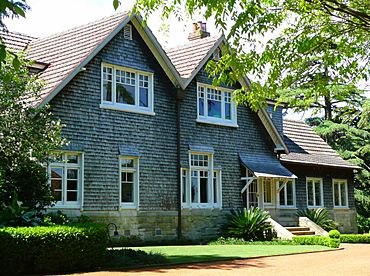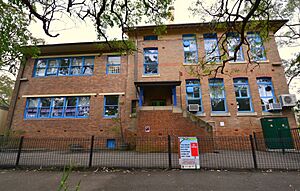Warrawee, New South Wales facts for kids
Quick facts for kids WarraweeSydney, New South Wales |
|||||||||||||||
|---|---|---|---|---|---|---|---|---|---|---|---|---|---|---|---|

Pibrac, Pibrac Avenue
|
|||||||||||||||
| Population | 3,170 (2021 census) | ||||||||||||||
| • Density | 2,440/km2 (6,300/sq mi) | ||||||||||||||
| Established | Early 1800s | ||||||||||||||
| Postcode(s) | 2074 | ||||||||||||||
| Elevation | 189 m (620 ft) | ||||||||||||||
| Area | 1.3 km2 (0.5 sq mi) | ||||||||||||||
| Location | 16 km (10 mi) north-west of Sydney CBD | ||||||||||||||
| LGA(s) | Ku-ring-gai Council | ||||||||||||||
| State electorate(s) | Ku-ring-gai | ||||||||||||||
| Federal Division(s) | Bradfield | ||||||||||||||
|
|||||||||||||||
Warrawee is a suburb located on the Upper North Shore of Sydney, in the state of New South Wales, Australia. It is about 17 kilometres north-west of the main Sydney city centre. Warrawee is part of the Ku-ring-gai Council area. It is mostly a place where people live, with only a few shops or businesses. Interestingly, the local train station does not have any shops, which is quite unusual for Sydney's train network.
It is important not to confuse Warrawee with "Wirrawee". Wirrawee is a made-up country town in the popular "Tomorrow series" of books by John Marsden. There was also a movie based on the first book, called Tomorrow, When the War Began (2010).
Contents
What Does "Warrawee" Mean?
The name Warrawee comes from an Aboriginal word. It is thought to mean "rest a while," "stop here," or "to stand."
A Look at Warrawee's History
Warrawee has a fascinating history, especially when it comes to its buildings. Many of its houses were designed by famous architects. Some of the earliest important homes include Pibrac (built in 1888), Cheddington (1890), and Wirepe (1893).
Famous Homes in Warrawee
- Pibrac: This house was built in 1888 for Frederick Eccleston Du Faur. He was a public servant and supported explorers. The house was designed by John Horbury Hunt, a Canadian architect. He liked the Arts and Crafts style and also brought the North American Shingle style to Australia. Pibrac is mostly made of timber with many timber shingles and sits on a sandstone base. It is a great example of Hunt's work.
- Cheddington: Built in 1890, this is the oldest home on Hastings Road. It is also believed to be designed by Horbury Hunt. It is made of brick with a slate roof and has his special shingle design.
- Wirepe: Designed by M.B. Halligan for architect Walter Traill in 1893. This house has large verandahs and high ceilings. It feels like a country homestead. It also has beautiful chimneys and cedar shingles.
- Upton Grey (now Kooyong): This house was built in 1894 and designed by John Sulman. Its English style makes it a local landmark. Over the years, it has been a government home, a science research station (for CSIRO), and a boarding house for Knox Grammar School. Today, it is a private home.
- Exley House: Located on Finlay Road, this house was designed by Harry Seidler in 1957. It was built for Cecil Exley, an engineer. This three-bedroom home is special because it is the only red-brick, single-story house Harry Seidler ever designed.
How Warrawee Grew
Like other suburbs on the North Shore with Aboriginal names, Warrawee was first the name of a railway station. Then, the area around it became known as Warrawee. In the early 1900s, Warrawee became a very exclusive residential area. It was designed to have no shops, offices, or churches. All the land blocks were large, between 1 and 4 acres. The types of houses built were also carefully controlled. Joseph Beresford Grant helped make sure the area stayed exclusive. He also made sure there were no shops nearby.
Getting Around Warrawee
The main road in Warrawee is the Pacific Highway. The Warrawee railway station is on the North Shore railway line of the Sydney Trains network. This station was built in 1900. It was the last station built on the North Shore Line before it reached North Sydney. Local people had to work hard to convince the railway company to build a station here. It is only one kilometre from the Wahroonga station.
In 2021, about 3.7% of people who worked in Warrawee used public transport to get to their jobs. This is a bit less than the national average of 4.6%. About 25.5% of people drove to work, either as a driver or a passenger. This is much lower than the national average of 57.8%.
One bus route goes through Warrawee, operated by CDC NSW:
- Route 573: This bus travels from Turramurra to Sydney Adventist Hospital.
Who Lives in Warrawee?
In 2021, the suburb of Warrawee had a population of 3,170 people. Here are some interesting facts about them:
- Age: The average age of people in Warrawee was 42 years old. About 18.1% of the population were children under 15. People aged 65 and over made up 17.3% of the population.
- Where People are From: More than half (57.7%) of the residents were born in Australia. The next most common countries of birth were China (10.3%), England (4.8%), India (3.3%), South Africa (3.0%), and South Korea (2.4%).
- Money Matters: The average weekly household income was $3,388. This is more than double the national average of $1,746. Because of this, house prices are also high. The average monthly mortgage payment was $3,500, compared to the national average of $1,863.
- Homes: Most homes (84.3%) were family households. About 14.7% were single-person homes, and 1.0% were group households. Separate houses made up 63.9% of all homes. Flats or apartments were 30.6%, and semi-detached homes were about 4.7%.
Schools in Warrawee
- Warrawee Public School: This is a primary school that opened in 1906. It is located about 0.5 kilometres south of the train station, on the Pacific Highway.
- Knox Grammar School: Most of this school is located in Warrawee. It is very close to Warrawee railway station, less than 200 metres away. However, the school's main office is in Wahroonga, so that is the address they use.
Famous People from Warrawee
- Joseph Beresford Grant (1877–1942): He was a developer and investor who helped make Warrawee an exclusive place to live. He lived in a house called Rowerdenan on Warrawee Avenue from 1913.
- Eleanor Cullis-Hill (1913–2001): She was an architect and the daughter of Joseph Beresford Grant.
- Sir Charles Mackellar and his daughter, poet Dorothea Mackellar: They were also residents of Warrawee.
- Olive Fitzhardinge: She lived in Warrawee from 1917 to 1937. She was famous for breeding a rose called 'Warrawee'.
- Kandiah Kamalesvaran (Kamahl): A well-known singer.
- Sir John Seymour Proud (1907–1997): Another notable resident.



